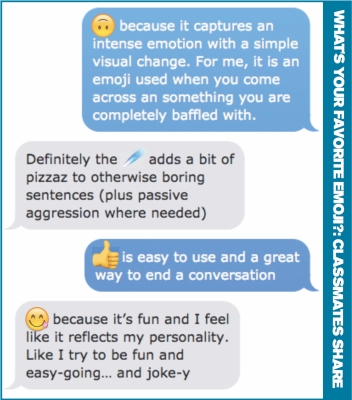Emojis: How Tiny Smiley Faces are Taking Over the World
Written by Stephanie Yang
Emojis are connecting cultures, translating subtweets, and sending mixed signals one smiley face at a time.
Since the invention of SMS, texting has changed the way we communicate with each other. While language has always certainly evolved via contractions, slang, and over 1,700 new words from William Shakespeare, the advent of technology has markedly changed the game—namely, through the smiley faces we know and love today: emojis.
Text messaging has grossly cut out the proportion of face-to-face interactions we have with one another. Non-verbal cues we usually employ like smiling, inflection, and body language are no longer factors when we text. Emojis help fix that. Humans use emojis as visual aids to weave emotional elements into texts and messages.
Cyber-psychological insights and emoji semantics are a relatively untouched field of research, but as technology becomes more intertwined with our lives, interest has grown. For example, just last year the very first emoji conference took place in San Francisco, California. The Emojicon was a 1,000 person “celebration of the characters we text to friends and an exploration of how they’ll continue to change our culture.” The conference brought upon a critical lens to the smileys and heart signs that accompany our messages, igniting discussions about new emojis that should be added, and how they can be interpreted.
Emojis make impressions; we make judgements of others based on the emojis they use, whether we recognize it or not. Emoji usage spans generations: a 2014 survey of over 1,000 people in the US found that only 54% of emoticon users were 18 to 34 years old. Instead of age, the emojis we tend to use can reflect personality traits like agreeableness. Paul Yoon, a junior studying Finance and Economics, feels similarly: “Generally speaking I would say that the more emojis someone uses the more animated and expressive they are in real life.” This relationship between emoji use and personality doesn’t seem to extend too deeply into our impressions of others. Jackie Zhu, a junior studying Finance and Marketing, has mixed feelings on this relationship: “I guess you can say people who don’t use emojis are more serious than those who don’t, but I don’t think that’s a strong correlation.”
The role of emojis is also subject to personal opinion because they have varying degrees of impact on a conversation. One 2019 Finance and Management major felt that “When someone uses emojis, it automatically lightens the conversation and makes me think that they’re more humorous and friendly. I don’t know if this is accurate, but I think that’s the perception.” A Stern junior studying Actuarial Science, dug deeper: “[Emojis] help elicit emotions you cannot convey through literacy. While words are ultimately visual, emojis provide deeper insight into the writer’s mind, extracting thoughts which cannot be explained in letters.”
Other students, however, recognize the pitfalls of emojis: “Emojis help make texting more interactive, though it creates a different set of expectations with prolonged usage such as overthinking when certain emojis aren’t used in a certain context.” Is the person you’re texting trying to be sarcastic with (smirk emoji) or are they trying to hint at something else (side eye emoji)?
One expert that has broken into the emoji space is Tyler Schnoebelen, who wrote his Stanford doctoral thesis on emoticons. Schnoebelen explains in an NPR interview that emoticons’ and emojis’ popularity comes from the increased access to resources we have to express ourselves. Schnoebelen also highlights the general spirit of emojis. According to Schnoebelen, people tend to use emojis for light-hearted, playful conversations, but avoid using emojis when they’re angry, grief-stricken, or upset.
Representation through emoji also matters. And as emojis have evolved, so has our use of them. Once skin color options were added into emojis, emoji use increased. Schnoebelen explains that before pigment played a factor in emojis, tweets about #BlackLivesMatters seldom included any emojis, since a yellow fist couldn’t convey the right message. Google has also recognized the importance of representation, changing female emoji clothes from pink to purple or blue tones.
Emojis reflect a new, technology-driven change to human language. To add even more layers of complexity, recent years have seen an upward trend in gif and sticker use. This past September, Apple even announced a new Animoji feature in iOS 11 that uses facial-scanning features to create a custom 3D version of an emoji based on a user’s face. Emojis have changed the way we communicate. They decode the hidden meanings behind our texts and tweets, and in many ways unite people across lingual, cultural, and geographic barriers, with the use of a single smiley face.
Interested in what your classmates’ favorite emojis are? Take a look below!

Graphic by Katherine Wang


Leave a comment